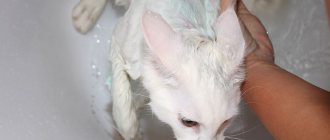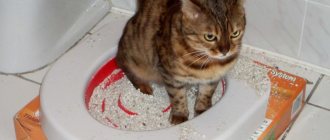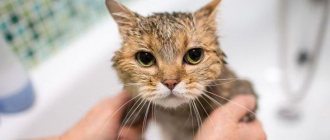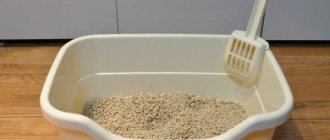Cats and cats are animals that wash themselves, carefully licking their fur. On the tongues of cats there are many hard villi located obliquely. Thanks to this structure of the tongue, the pet’s fur takes on an attractive appearance after licking. The natural lubricant produced by the animal's skin glands also has a beneficial effect on the appearance of the fur coat. Frequent washing is contraindicated for a cat, because detergents will quickly cause the fur coat to lose its appearance. There are situations when you cannot do without water. How to bathe a cat if he is afraid of water?
Causes of hydrophobia in cats
Dogs, unlike cats, are not afraid of water and calmly tolerate the bathing process. A cat may become nervous due to a sudden change in the environment and behavior of the owner or mistress. He experiences a feeling of fear not so much of the “terrible liquid” as of immersion in it.
Fun fact! The water is clear, so the cat cannot see where its real boundaries are and begins to panic.
Whatever one may say, during the water procedure the cat must always be held tightly so that it does not scratch the owner or cause harm to itself during sudden movements. Being squeezed in a strong “hug” of a person, cats experience stress and sometimes an uncontrollable feeling of fear: “What is happening?” In addition, if there is no support (wall or shelf) for which the cat clings with its claws, it panics even more.
Is it possible to dry hair with a hairdryer?
After bathing a pregnant cat, some owners may be tempted to dry its fur with a hairdryer to prevent the expectant mother from catching a cold. The idea is not bad, but it can only be implemented if the cat is not afraid of the noise of the hair dryer and often basks under the stream of warm air, turning over from one barrel to another. If, at the sound of the hair dryer being turned on, the cat begins to rush around the room, trying to hide in a secluded corner, you should not injure it even more. It’s better to take a large soft towel, wrap your pet in it and gently dry it with calm stroking movements.
Preparing for the bathing procedure
Washing a cat if he is afraid of water is not an easy task. You need to carefully prepare for the procedure. The main thing is that all useful items are nearby and can be used at any time. There are several of them:
- two or three dry towels (for wrapping the cat after a bath);
- the same number of towels or clean rags (to prevent water from spreading across the floor);
- cat shampoo (the choice depends on the type of pet’s coat). You can’t wash cats with regular shampoos, as well as detergents for dogs;
- two small basins (in one there will be a soapy cat, and in the other it needs to be rinsed);
- a ladle or a large cup (for rinsing the fur after soaping).
The water temperature for swimming should be from +36 to 38C. Also prepare iodine or brilliant green in case the cat breaks out and scratches you out of fright. Wear a shirt or long-sleeve shirt to avoid serious scratches. Trim your cat's claws in advance. It is better to carry out the procedure together: one person carefully holds the animal, and the other soaps it, pouring warm water from a ladle.
If there are a lot of bottles and other containers in the bathroom, be sure to put them away. If a cat gets out, it can make such a mess that it will take a very long time to clean it up.
The first procedure for washing a cat
It is quite possible to wash a cat if he is afraid of water. The owner or hostess should prepare for this psychologically so that inevitable incidents do not come as a shock and surprise. You cannot scold an animal, let alone shout at it. It is important to show maximum patience by holding your pet tightly and constantly talking to him in a calm voice.
The correct way to hold your furry animal while washing is down and up at the same time. One hand should be under the stomach, and the other should hold the front paws. This is the only way the cat will not be able to scratch you. Lower your pet into the water as slowly as possible. If he starts to meow and struggle, calm him down in a confident but soft voice. Cats respond to the intonation of human voices and often calm down.
The fur should be slightly moistened with water, pouring from a ladle or mug, and then begin soaping. Do not allow shampoo to get on the animal's face or ears to prevent inflammation. Wash off the foam gradually until it disappears completely. If the foam is not completely washed away, the cat may swallow soap while licking the fur. After the foam is completely washed off, you need to wrap the animal in a large towel so that it absorbs as much water as possible from the fur. When the towel gets wet, it is immediately replaced with another.
When releasing a wet cat indoors, make sure that there are no drafts in the house or room, otherwise the animal may catch a cold and get sick. It is best to plant or put it in a warm place to dry out and survive stress.
The correct algorithm for washing cats for all occasions
In the future, when the cat undergoes a “baptism of fire” with the first bath, follow a simple algorithm of actions:
- always prepare the bathroom, removing everything unnecessary;
- the more towels prepared, the better;
- hold the animal tightly;
- Before lowering the animal into the water, make sure its temperature is constant;
- lather the fur with a small amount of cat shampoo (this makes it faster and easier to wash off);
- It is better to foam a cap of the product and distribute it evenly over the back of the animal using a special mitten.
Helpful advice! You can prevent water from getting into your cat's ears by covering them with special tampons.
Direct the shower stream carefully, following the path of your pet's fur. The bulk of the water should fall on the back, and then be smoothly distributed throughout the animal’s body, simultaneously washing the fur. Rinse off the shampoo from top to bottom.
Newbies to bathing cats think they won't sit wrapped in a towel, but that's not true. Of course, the animal will carefully shake itself off and lick its fur, but at first it can sit quietly in a towel, because it absorbs moisture and retains heat.
When not to swim
There are situations when it is better not to wash even a very dirty pet. So, you should not swim:
- cats during advanced pregnancy;
- all recently vaccinated animals;
- cats suffering from any skin disease (on the advice of a doctor);
- animals with an easily excitable nervous system and heart disease;
- cats who have recently suffered from pneumonia and some other diseases.
In addition, you definitely shouldn’t wash your pet if it’s cold in the house. The optimal temperature for swimming is not lower than +25°C.
Mistakes when bathing cats
Never turn the tap on all the way before putting your pet in the bath. The noise of the water will immediately frighten the cat, he will begin to meow loudly and struggle. If your pet is scared, you will have to stop using ear swabs so as not to scare him even more.
Frivolous cat owners, trying to save money on special shampoos, think that animals can even be washed... with dishwashing detergents. Do not make such a mistake under any circumstances, because the hair will become matted for a long time after using this product. Do not pour shampoo onto the fur directly from the bottle, trying to save time. This may cause skin irritation. Also, do not give your shaggy animal any sedatives before bathing, so as not to harm his health.
Advice from experienced cat lovers
Experienced cat owners know many secrets: how to wash a cat and stay alive, why they use citrus peels and much more. Some of them may seem strange to you, but they work, and that's the main thing.
If you want to wash your kitten clean, but are afraid that it will scratch you, use the proven “grandmother’s” method: put it in a large cotton sock, leaving only its head outside, and “wash” it with it.
If you have to bathe the cat yourself, it is better to do this not in a bathtub or basin, but in a stable plastic bucket with a volume of 8-10 liters. There is no place to turn around in it, so after one or two attempts to break out, the cat will sit on the bottom, cling to the side with all ten claws and allow you to calmly wash it. Tested many times!
Before you start driving out insects with the help of some anti-flea shampoo, wet the cat's neck: if they try to escape, the fleas will not be able to get onto his head.
Pour the skins of one or two lemons or tangerines with two glasses of hot water and let them brew. Pour the aromatic infusion into a spray bottle and periodically spray your pet with it. He will never have fleas.
If your pet gets dirty with an oily substance, you can get rid of it by rubbing melted butter on the stains and then removing the oil with a paper towel. After this, of course, the animal must be thoroughly washed.
We hope our tips were useful to you and you can wash your pet without the slightest difficulty.
List of detergents
As already mentioned, you need to use only special shampoos for cats. Even if your pet is not a purebred cat, you should not neglect its physical and mental health. If you wash a cat with ordinary soap, its fur will fade. It will quickly develop dandruff. The animal will constantly itch, which can cause not only skin irritation, but also serious illnesses. When purchasing “human” shampoos, we always pay attention to their suitability for our hair type. It’s the same story with cat hair, so you need to choose a product taking into account the specifics of your pet’s fur.
Anti-flea shampoos
A cat often gets fleas, especially if he spends the summer at the dacha. In addition to special drops and flea collars, there is a whole range of shampoos that remove both adult fleas and their ovipositor. For prevention, you should wash your cat with this product once every six months. If the animal has fleas, a repeated procedure may be required until they are completely destroyed. If you have adopted a street kitten or an adult cat, you definitely need it. After two or three weeks after your furry friend has gotten used to your house or apartment, you can wash him with anti-flea shampoo.
Dry shampoo for cleaning cats
This is the most humane method of cleaning an animal's fur. During treatment, the cat behaves calmly and does not show nervousness. Like liquid shampoo, the “dry” product is used once every six months. The process itself is similar to daily combing, but it cannot be done on a carpet or rug. It’s easy to wash off traces of powder from an uncovered floor, but if they get on the carpet, you’ll have to tinker with cleaning. Rub a small amount of powder into the fur, then take the animal's favorite comb and comb it out.
How often should you bathe your furry pet?
There are several opinions on this matter, which have their supporters and opponents. In fact, it is impossible to establish clear time periods during which a cat needs hygiene procedures.
The frequency of bathing cats depends on many factors. For example, one cat who lies on the couch all day long and licks himself down to the line can be bathed once a month, and this will be quite enough for him, but at the same time, if you take another cat who is lazy to lick himself after going to the toilet, he you will need to bathe more often.
How often a cat should be bathed is decided only by its owner. See for yourself, based on your pet’s character traits, the conditions in which he lives (how often he goes out for walks), and, of course, the needs of your furry friend. During such periods when your cat's fur is shedding, you can bathe him a little more often than usual to help him quickly renew his coat and cope with this problem.
But, it is worth understanding one important nuance - the fur of every cat, regardless of whether it is indoor or prefers a free life, is covered with a special, natural protective layer of secretion, which is produced by glands located in the skin of the animal.
If you bathe your cat too often, or use the wrong shampoo, you risk compromising this natural defense, which can cause health problems for your cat.
The first is a violation of thermoregulation processes. The cat’s immunity and stamina also suffer. Therefore, it is worth remembering that too frequent bathing may not be beneficial, but on the contrary, harm your furry friend.











